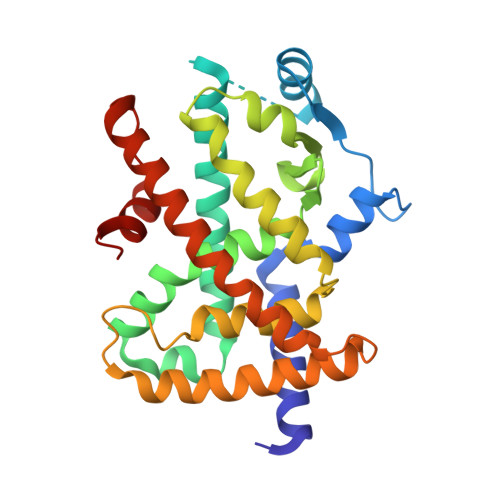Different binding and recognition modes of GL479, a dual agonist of Peroxisome Proliferator-Activated Receptor alpha / gamma.
dos Santos, J.C., Bernardes, A., Giampietro, L., Ammazzalorso, A., De Filippis, B., Amoroso, R., Polikarpov, I.(2015) J Struct Biol 191: 332-340
- PubMed: 26185032
- DOI: https://doi.org/10.1016/j.jsb.2015.07.006
- Primary Citation of Related Structures:
4CI4, 4CI5 - PubMed Abstract:
Peroxisome Proliferator-Activated Receptors (PPARs) are ligand-dependent transcription factors that control various functions in human organism, including the control of glucose and lipid metabolism. PPARγ is a target of TZD agonists, clinically used to improve insulin sensitivity whereas fibrates, PPARα ligands, lower serum triglyceride levels. We report here the structural studies of GL479, a synthetic dual PPARα/γ agonist, designed by a combination of clofibric acid skeleton and a phenyldiazenyl moiety, as bioisosteric replacement of stilbene group, in complex with both PPARα and PPARγ receptors. GL479 was previously reported as a partial agonist of PPARγ and a full agonist of PPARα with high affinity for both PPARs. Our structural studies reveal different binding modes of GL479 to PPARα and PPARγ, which may explain the distinct activation behaviors observed for each receptor. In both cases the ligand interacts with a Tyr located at helix 12 (H12), resulting in the receptor active conformation. In the complex with PPARα, GL479 occupies the same region of the ligand-binding pocket (LBP) observed for other full agonists, whereas GL479 bound to PPARγ displays a new binding mode. Our results indicate a novel region of PPARs LBP that may be explored for the design of partial agonists as well dual PPARα/γ agonists that combine, simultaneously, the therapeutic effects of the treatment of insulin resistance and dyslipidemia.
- Grupo de Biotecnologia Molecular, Instituto de Física de São Carlos, Universidade de São Paulo, São Carlos, SP 13566-590, Brazil.
Organizational Affiliation:

















